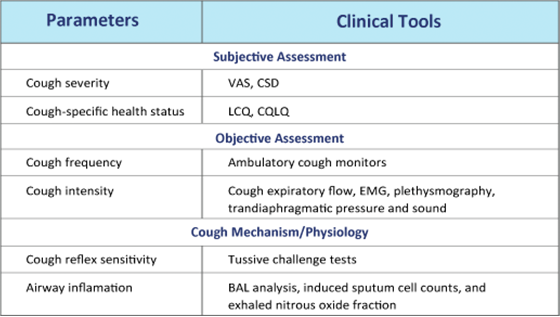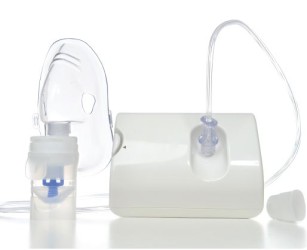Respiratory conditions are on the rise worldwide, and especially in developing countries like India which accounts for an estimated 18% of the world population. Findings from the Global Burden Disease Survey 1990-2016 make it clear that both acute and chronic respiratory diseases are highly prevalent in the country. Air pollution, tobacco, biomass fuels, and occupational exposures continue to overburden the Indian healthcare system with a variety of respiratory ailments, of which ‘cough’ remains the most common initial presenting symptom.1,2
Qualitative and Quantitative Cough Assessments Are Crucial To Optimize Disease Outcomes


Not only is cough an important indicator of underlying lung pathology, but
cough pattern is known to be a key biomarker for the assessment and monitoring
of acute or chronic pulmonary conditions. A detailed cough assessment can be
helpful in objectively evaluating treatment responses to
pharmacological/non-pharmacological antitussives, play important roles in
predicting transmission of communicable respiratory conditions, and evaluate
airway responsiveness in patients with neuromuscular conditions.
With such wide implications, it becomes important for a clinician to assess and
document the cough using clinically validated tools.3,4
Several tools for subjective and objective measurement of cough exist, and
their usage has been instrumental in advancing clinical and preclinical
research and the advent of promising new treatments. These include methods for
measuring cough-specific quality of life, subjective severity, cough frequency,
intensity, and sensitivity of the underlying cough reflex.5

Subjective assessments help a clinician understand a patients’ personal
experiences of cough,thereby assessing associated psychosocial elements that
may otherwise be under-recognized.
Subjective assessments focus on the symptom of cough itself, such as cough
severity, and the effects of the cough on a patient's general health status,
such as cough-related quality of life.
● The Cough Severity Visual Analogue Scale is a standardized VAS 0- to
100-mm linear scale on which higher scores indicate higher severity.
● The Cough Severity Diary is a 7-item outcome measure with an 11-point Likert
scale for each item in which higher scores indicate higher severity.

● The Leicester Cough Questionnaire consists of 19 items addressing
physical, social, and psychological domains, with a 7- point Likert scale in
which higher scores indicate better health status.
● The Cough Quality of Life Questionnaire comprises 28 items in 6 domains that
include physical complaints, extreme physical complaints, psychosocial issues,
emotional well-being, personal safety fears, and functional abilities.
Each item is rated with a 4-point Likert scale in which lower scores
indicate better QOL.
There are tools available to assess and quantify cough frequency, intensity,
and cough reflex sensitivity which help a clinician standardize and objectively
document their evaluation.
● Ambulatory cough frequency monitors such as Leicester Cough Monitor
comprises a portable battery-operated digital sound recorder and a lapel
microphone that captures and records all sounds for 24 hours or longer. The
recorded data is run through a custom-built detection algorithm to analyze and
identify cough frequency.
● The force or intensity of coughing is an important parameter for assessing
cough efficacy. Measurements of Cough Expiratory Flow Rates, Electromyogram
activity of respiratory muscles, and Cough Sound Amplitudes are helpful markers
of cough intensity assessment.

A controlled inhalation of pro-tussive compounds such as capsaicin is
utilized to evoke a cough reflex and their minimum concentrations required to
elicit the same is recorded. These Tussive Challenge Tests
find wide implications in early phase evaluation of antitussive medications and
to investigate the risk of respiratory complications in patients with
neuromuscular diseases.
Current Research and Ongoing Developments in Cough Assessment
There is much interest in utilizing digital offerings to develop novel cough
assessment tools. Considerable work is currently underway to test and analyze
these technologies. Some recently published and notable work includes -
Lung congestion, which results in a wet cough or sputum
production, is a strong indicator of numerous pulmonary conditions ranging from
respiratory infection to more serious diseases such as pneumonia and cancer.
Nemati E et al, [2020] objectively evaluated the presence or absence of
lung congestion through a smartphone recording and a multi-layer labeling
platform with a system architecture comprising of Sensing, Annotation,
Pre-processing, Feature Engineering and Classification.

Hand held cough testing was a novel setupused by Curtis et al. [2020] which
consisted of a facemask coupled to a handheld nebulizer and an analog peak flow
meter. The HCT identified differences in cough airflow and sensation during
reflex and voluntary cough tasks with high sensitivity and can be a portable,
affordable, and a clinically feasible tool valid for cough assessment,
dysphagia screening, and potentially identifying people at risk of aspiration
pneumonia.
